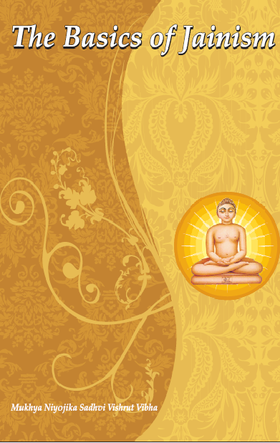The synods to revive the agama
Approximately one hundred and sixty years after Lord Mahavira's nirvana, a severe famine occurred that lasted for twelve years. During that period of scarcity, it become extremely difficult for the Jain monks and nuns to follow the code of conduct laid down by their Lord. It was impossible for them to retain the extensive lore of the Agamas in their memories, and since there was no tradition of writing the Agama, varying and incomplete versions remained. Therefore, a convention was held at Patliputra after the famine under the leadership of the venerable Sthulbhadra. In that synod, a uniform edition of all the Anga Agamas was prepared. In the historical Jain tradition, this is known as the first vachana (synod) of the Agama.
The second attempt to save the Agama was made during the period between Vir Nirvana era 827 to 820 Two conventions (vachana) were held - one at Mathura and the other at Vallabhi. The former convention was presided over by Acharya Skandil and the latter by Acharya Nagarjuna. The Vachana are referred as Mathuri Vachana and Vallabhi Vachana.
Both Vachanas were held at different places at the same time. During this period the agamas were collected and compiled. They were given written form in the last Vacana of Vallabhi.
Prior to that time, the Agamas were not yet written, they were orally transmitted. The last convention was held in Vallabhi after Vir Nirvana (year 980) under the guidance of Devardhigani Ksmasramana. By this time, large portions of the sutra which had been passed down from generations orally, were forgotten. Whatever could be revived by memory was written down and systematically organized and presented in the form of the Agamic text.
Commentary Literature
The Jain sutras have four forms of their commentaries viz. the Niryukti, Bhashya, Churni and Tika (vrti).
The Niryukti is written in the prakrit language, in a form of a verse called Gatha. Acharya Bhadrabahu (8th century) is considered to be the most renowned writer of Niryukti.
Bhashya is also written in Prakrit verses. Jinbhadragani (7th century) and Sanghadasagani (6th century) are the most famous writers of Bhasyas.
Churnis were written in prose having a mixture of both Prakrit and Sanskrit language.
Jinadasagani (8* century) and Agastya Singh are considered the most authentic authors of Churnis. Tika is a form of commentary written exclusively in Sanskrit and explains all prakit words in Sanskrit.
Acharya Haribhadra (8th century), Silank and Abhayadeva (11th century) were the writers of Tikas. Abhayadeva (11th century) wrote the commentaries on nine Anga. Acharya Haribhadra (8th century), Acharya Silanka Malayagiri and Maldhari Hemchandra (12th century) were also known writers of commentaries.
Other renowned Jain scholars are Siddhasen(5th century), Umaswati(3rd century),
Samanthbhadra(4th, 5th century), and Mantung (12th century). They were scholars of philosophy but also wrote extensively on grammar, geography and a variety of other subjects.
Acharya Haribhadra, a Brahmin by birth, who later converted to the Jain faith, is composed 1444 Prakarana (short treatises) on various subjects. Yogavimsika Yogasatak, Yogadristisamuccaya and and Yogbindu Prakarana are the best examples of his works. Acharya Hemchandra(12th, 13th century) was one of the most eminent authors of Jain literature. He wrote the famous Siddhahemshabdanusasana, a treatise on Sanskrit grammar in Sanskrit language. It is said that he could dictate hundreds of different subjects simultaneously to 84 different scribes, never losing the sequence of his thoughts. In addition to the works on grammar in Sanskrit and Prakit, he also dealt with a variety of Jain topics.
Upadhyaya Yashovijayaji(18th century) was a prolific writer. He has written on nearly every aspect of Jainism in Sanskrit, Prakit and Gujarati. He wrote his work on Nyaya in the Navya-nyaya (i.e. neo-logic) style. His work Anekanta Vyavastha (also written in the Navya-nyaya style) helped re-establish the Anekantvada. Likewise, Jaintarkabhasa and Gyanabindu are two important contribution of Jain in field of Pramanashastra, and Nayapradipa and Nayarahasya one the important works on Nayavada.
Contemporary Works
In the field of literature, scholar of 21st century scholars like Pandit Sukhalaji Sanghavi, Pandit Mahendrakumarji Jain and Pandit Dalsukh Malvaniya have successfully provided new interpretations of ancient works. Most recently Dr. A.n. Upadhya, Dr. Hiralal Jain and Dr. Nathamal Tatia have also edited many ancient texts with critical commentaries.
At present, H.H. Acharya Mahapragyaji 21st century has been performing the enormous task of editing the jain canonical texts along with critical notes on them. He began his work under the auspicious guidance of the (Late) H.H. Gurudev Shree Tulsi in 1954A.D. All the thirty two principal texts have been published by Jain Vishva Bharati Ladnuninl974.
Many foreign scholars shows great interest in Jain teachings and literature. Some of them have translated Jain works into their respective native tongues. Professor Herman Jacobi, a German scholar, translated four Jain Agama into English, making them widely accessible to the world. His series of works are called "Sacred Books of the East". Many other scholars, such as Professor Walther Schubring, Professor Alsdorf, Joseph, Deleu, Norman, and Brown have taken a keen interest in Jain philosophy as a result of these works. Their efforts are largely very successful and commendable.
Among the modern Jain literature that is available today, very little deals with the original teachings of Lord Mahavira. However, the under-utilised resource of canonical texts contains the most valuable and precious material for scholars of comparative religions.
Recently, Muni Punya Vijayji and Muni Jambu Vijayji have made important contributions to Jain studies by preparing critical editions of canonical and other ancient texts of the Shvetambar tradition. The Digamber Acharya Muni Vidyanandji has undertaken the commendable task of editing with annotations some of the sauraseni texts.
